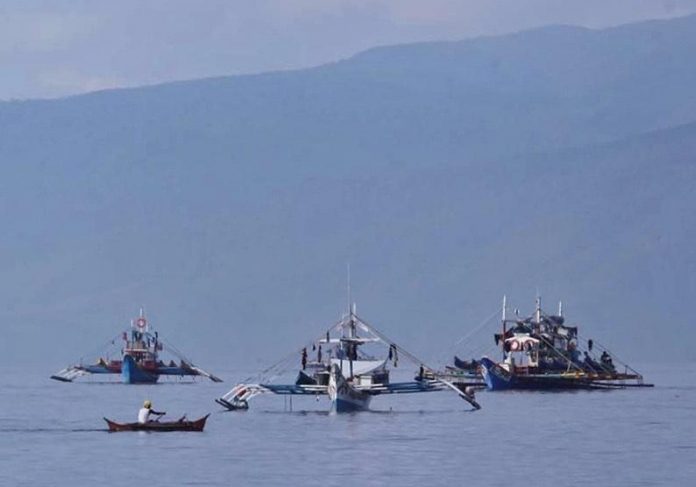
The Interfacing Development Interventions for Sustainability (IDIS) Inc. underscored that despite claims that the Austral-Asia Link Mining Corporation and Hallmark Mining Corporation mining site is outside the protected areas of Mt. Hamiguitan and Pujada Bay, it still has extensive impacts to the environment.
This is in line with the statement issued by the Mati City Information Office assuring that the said mining firm is outside the protected areas after its photos surfaced recently causing concerns among residents.
The Mati City Environment and Natural Resources Office (CiENRO) said on May 23, 2022 that the said mining area, which comprises a total area of 17,215.49 hectares, is four kilometers away from the boundary of the Pujada Bay Seascape which is a protected area.
CiENRO also assured that it is also outside the Mt. Hamiguitan Range Wildlife Sanctuary which is a UNESCO heritage site.
In a statement, IDIS remained firm on its stand that the Pujada Nickel Open-Pit Mining Project in Davao Oriental has extensive environmental and social impacts despite the claim that the said mining site is outside the protected areas of Mt. Hamiguitan and Pujada Bay.
The Pujada Nickel Project is one of the 23 priority mining projects that are part of the Philippine government’s 2004 Minerals Action Plan. Hallmark Mining Corporation (HMC) and Austral-Asia Link Mining Corporation (AALMC) are Philippine companies under the management of Asiaticus Management Corporation (AMCOR) that currently hold control of the Pujada Nickel Project. The Mineral Production and Sharing Agreements (MPSA) granted to these mining companies give the right of ingress and egress for the next 25 years and are renewable for the same period.
“What alarms us is that the Pujada Nickel Open-Pit Mining Project straddles between and within close proximity of Mount Hamiguitan Wildlife Range, a UNESCO Heritage Site and protected by Republic Act 9303 and Pujada Bay Protected Seascape and Landscape through Presidential Proclamation 431 and Republic Act 7586. Regardless of the claim that it is outside the protected area delineation, we strongly uphold and fight for the ecological rights and integrities of these watersheds from ridge to reef,” it said.
The group explained that portions of these protected areas are within a proximity radius of only 8 kilometers from the open-pit mining site. Eight kilometers north-east from the mining site is already Pujada Island and eight kilometers heading east is already the peak and highest elevation point of Mt. Hamiguitan.
“The environmental impacts of open-pit mining affect water quality, air, hydro-geology, biodiversity, resources, and communities in a wider and regional scope and could not be contained compactly as pollution will always exceed spatial boundaries and delineations,” the group said.
IDIS also emphasized that the Pujada Nickel Project overlaps 16,000 hectares of ancestral domain claims of the Mandaya Indigenous People; thus, there is a need to secure Free Prior Informed Consent (FPIC), especially coming from the indigenous stakeholders.
“However, the FPIC was only achieved by establishing an arbitrary and illegitimate Council of Elders, not recognized as an authority by the majority of the Indigenous people. The Macambol-Mamali United Mandaya Tribal Council said that their members were not sufficiently consulted about the project and were not permitted to speak and raise objections to the mining project during meetings with the NCIP. The mining’s negative effects on the Mandaya tribe will lead to the loss of their lands, and a serious threat to their livelihoods, local resources, and cultural preservation,” the group stated.
With these risks to the above-mentioned sectors, IDIS is calling on Regional Executive Director Bagani Fidel A. Evasco of the regional office of the Department of Environment and Natural Resources (DENR 11) for the full closure of open-pit mining in Macambol and halting of its Mining Production Sharing Agreement (MPSA).
The group has also called on the City Council of Mati and Governor Generoso and DENR 11 to declare these areas as buffer, greenbelt, and transitional zones, particularly “environmental critical areas” or “critical habitats” as stated in the Philippine Wildlife Act.
IDIS also called on the two Protected Area Management Boards (PAMB) of Mt. Hamiguitan and Pujada Bay to have cohesive and interlinked planning to close off the open-pit mining, a highly destructive activity in these areas.
Meanwhile, the Mati CiENRO also clarified that the mining operation has been issued a Mineral Production Sharing Agreement (MPSA) by DENR in 2004 and has been in operation since then.
Aside from the MPSA, the mining companies jointly operated by Hallmark Mining are also given the environmental compliance certificate (ECC) by the national government which certifies that “the development, construction and operation of the mine/quarry will not bring about unacceptable environmental impacts”.






